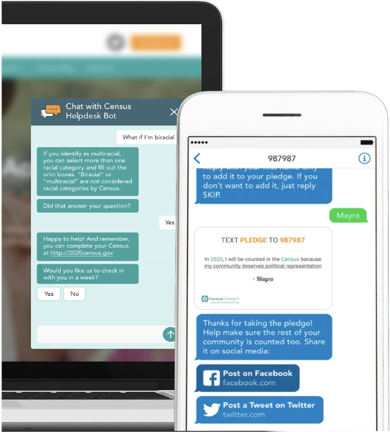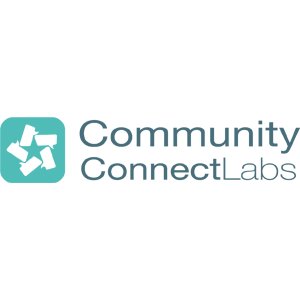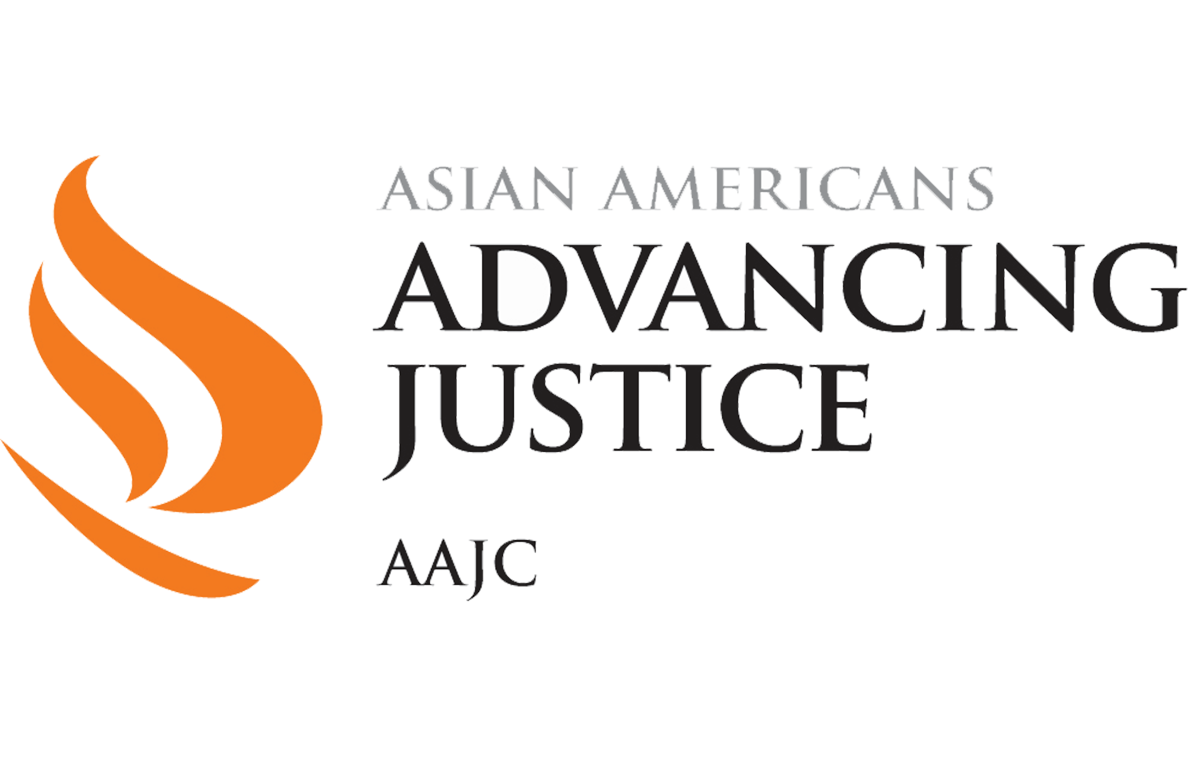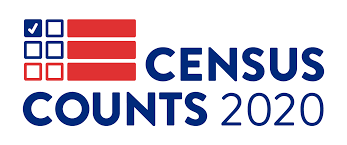The major social media platforms are constantly changing what content they allow to be shared, and how their platforms operate. It is strongly recommended that GOTC organizations pay close attention to the policies of specific platforms that play a big role in your outreach programs. Below are just a few recent updates of note:
Download the PDF.
Click here.Get training on digital organizing.
Click here.Digital Organizing Trends, Tips and Tools for GOTC Outreach and Building Longer Term Capacity
Section I. Introduction and Overview
The content below is meant to inform outreach strategies for mobilizing historically undercounted communities towards participation in the 2020 Census—it does not address the actual process of enumeration. For guidance on that, please see the resources available here.
To meet Hard-to-Count (HTC) populations where they are, effective outreach practices for civic engagement in the twenty-first century should be considered, in addition to tried-and-true traditional approaches. Digital organizing—defined here as using digital tools, data, platforms, and practices to inform, engage, and mobilize people to take action and build long-term capacity—provides a promising opportunity to integrate relevant communications and data technology into Get Out the Count (GOTC) outreach programs.
GOTC outreach efforts should be open minded and forward thinking about digital and data; not only for immediate efforts like the 2020 Census, but also for the longer term implications certain practices may have.
That all being said, strategic digital organizing can help get out the count, bolster your organization’s longer term digital capacity, and may have relevance to addressing the digital divide in many HTC communities.
This section of the Census Counts Toolkit will cover:
✅ Trends, Practices, and Recommendations for Digital Outreach to Specific HTC Communities
✅ Examples of Specific Tools and Practices Currently Being Used in the Field
✅ Templates and Additional Resources for Deeper Learning
Section II. Digital State of Play Since 2010
Since the 2010 Census, there has been a dramatic increase in mobile and online engagement, particularly the use of smartphones and social media. Texting, social media, and online video are particularly relevant areas that have seen significant growth. The migration from traditional media to online, mobile, and social media is widespread and cuts across demographics.
Here are a few topline figures to consider that illustrate some of the shifts:
- 95% of Americans now own a cellphone of some kind.
- 77% of Americans now own smartphones, up from 35% in 2011.
- As of 2018, roughly one in five American adults are “smartphone-only” internet users.
- 31% of Americans with an annual household income of less than $30,000 are smartphone-only internet users. Reliance on smartphones for online access is especially common among younger adults, non-whites, and lower-income Americans.
- 54% of Americans report getting news from social media sites “sometimes” or “often.”
Read more at the Pew Research Center Mobile Fact Sheet.
SMS (Texting)
Short message service (SMS), or texting, has emerged as a widely used civic engagement and commercial marketing tactic. SMS has been widely used for voter turnout, and when the key inputs are in place, it can be a cost-effective mode for direct constituent engagement. There are different types of SMS, and it’s important to be aware of the relationship between the sender of a text and its receiver, e.g., whether it is a “cold”( no pre-existing relationship between the sending organization and the receiver) or “warm” (when the sender has a pre-existing relationship with the recipient of the message).
Consider that as of EOY 2019:
- 67 text messages per day are exchanged by the average millennial.
- SMS (text messaging) can have open rates as high as 98%, while email generally peaks around 20%.
- In 2015, approximately 97% of smartphone owners reported using SMS.
While existing data sets, e.g., voter files do have large sets of cell phone numbers for individuals listed, it cannot be assumed that your target Hard-to-Reach universes will be reachable through data sets used for traditional voter contact. Organizations need to be strategic and plan early to maximize the use of SMS for GOTC outreach, and be forward thinking about safe and secure data collection as soon as possible.
A few different SMS tools and platforms currently being used in the field are listed in the GOTC tools map.
Online Video
One of the most dramatic shifts in the digital space has been the growth of online video content—video clips (both professional and self-produced), TV shows, and movies streamed from the internet. More people are consuming—and producing—video content, and this is happening increasingly on smartphones.
- 85% of the U.S. internet audience watches videos online.
- One-third of all online activity is spent watching video.
- Over half of video content is viewed on mobile.
- 92% of mobile video viewers share videos with others.
A few different video production tools and platforms currently being used in the field are listed in the GOTC tools map.
Decline of Trust in Mainstream Media and the Rise of Social Media
According to a Gallup/Knight Foundation 2018 report, most U.S. adults reported that they have lost trust in the news media, signaling fundamental changes are occurring in how people are consuming and sharing news and information. Meanwhile, 72% of Americans use social media, up from 47% in 2010.
Trusted messengers are more important than ever, particularly when it comes to cutting through misinformation, which is prevalent on social media. More than half of Americans rely on social media for news, but one-sided and inaccurate news are viewed as the biggest problems with social media. Community-based organizations are well positioned to identify trusted messengers in specific communities, and with some of the new tools available may be able to scale the reach of local influencers in ways unimaginable just a short time ago. But it’s critically important that information that is shared via social media is accurate and comes from trusted sources.
Harvard Kennedy School’s Shorenstein Center has a free online course on identifying misinformation online.
Policy Changes by the Platforms and Security Concerns

Facebook made significant changes to News Feed algorithm in 2018: Only designated “news” organizations can do ongoing free large-scale messaging on Facebook Messenger, and it continues to increase its privacy features on groups. Facebook also announced it will restrict the number of ads a page can run at once. More FB Messenger changes are expected in early 2020.
YouTube changed its terms of service to explicitly state the platform is “under no obligation to host or serve content” and can remove videos at its “sole discretion. It also introduced a feature to block channels as recommendations in the “up next” feature.
Twitter recently banned some political advertising. While that shouldn’t apply to census, it is important to monitor how these changes play out.
Instagram began removing “like” counts on posts from U.S. accounts, and added a “join chat” option to the “stories’’ feature.
The FCC is constantly changing rules around mass SMS messaging. In 2018 it ruled that that SMS and MMS are not functional equivalents of commercial mobile services, viewing them more akin to email.
Additional Challenges to Be Considered for GOTC Digital Organizing
- Organic reach at scale on social media platforms is challenging—paid promotion is often required to reach significant audiences
- Lack of multilingual and culturally competent tools and materials
- Privacy concerns around data and security
- General mistrust due to political climate, misinformation, and general hostility online
- Too many digital vendor pitches with little expertise of the unique challenges of the census
Section III. Asking the Right Questions and Knowing What You Want
For effective digital organizing, there is no “silver bullet” approach, and finding the right tools and platforms may take time. Integrate your digital organizing efforts as much as possible with your overall GOTC program, and do the front-end planning as soon as possible.
As you embark on your digital organizing planning effort, here are some questions to think through for finding the right digital tool:
- What are your primary GOTC outreach goals, and how are you deciding them?
- What are your plans to hit those goals?
- What is your target constituency for outreach? What are their media habits, and what platforms are they on?
- Does a particular tool or digital practice make sense on a broader cost benefit analysis relative to those plans?
- Do you have staff and volunteers on hand with the adequate skills to carry out your digital plans? If not, how do you plan to recruit?
And here are some core capacity buckets for an effective digital organizing plan:
- Creative Development and Distribution—creating informed content through experimentation, and having available channels to distribute it for desired levels of engagement
- Constituent Relationship Management (CRM)—technology and people capacity for the effective utilization of data to effectively engage a target audience and constituency
- Analytics, Evaluation and Data—being able to test and understand what works
- Social Listening—ability to have an accurate feedback loop with your constituents and facilitate more two-way conversation
- Paid Digital Advertising—not for everyone, but can be effective to expand reach online
When you’re ready to take this a step further, check out how specific HTC communities are engaging digitally:
Section IV. Digital Tools for GOTC
It’s important to remember that tools are just that—tools! People-power is essential to any successful GOTC effort, and we caution against too much emphasis on tech tools without thinking holistically about your overall program. Investments in staff and volunteers are essential, and be wary of any “silver bullet” tool recommendations. Tools are not a strategy, and they can be unfamiliar and intimidating to many organizers. There are often costs, skills, privacy, and cultural barriers to the proper utilization of certain tools and practices, and these barriers must be considered in the formation of any digital strategy.
Below is a framework from Community Connect Labs (CCL) on how to strategically think about your utilization of digital tools, as well as an overview of what’s currently being used in the field.
Digital Tool Do’s and Don’ts from CommunityConnect Labs
Contact and Learn More: Kristin Merkel, [email protected]

CCL’s Census 2020 Digital Outreach Checklist
On-the-ground outreach needs to be reinforced by digital solutions to be effective. Trusted messenger outreach efforts are much more likely to be effective if they pair their on-the-ground outreach with digital solutions that enable follow-through and follow-ups with nudges, reminders, and with services to answer people’s questions and help with completing the survey.
Solutions developed and deployed for census outreach need to be designed to be used by low-income, immigrant, minority, non-English speaking, and other Hard-to-Count (HTC) people. As such, a different set of tools and approaches are necessary compared to traditional GOTV tools.
Here are features to look for when you are shopping for census outreach tools:
1. Language Accessibility: Available in Multiple Languages
Too often, civic engagement tools assume use by a volunteer who reads and speaks English to reach a prospect who reads and speaks English. However, with a significant number of nonprofit staff and volunteers involved in census outreach who are immigrants/non-English speakers, and prospects who are also limited English speakers, Census 2020 digital tools need to be in multiple languages. For instance, if your nonprofit seeks to reach people in 6 languages, your digital tools should also be in 6 languages.
Furthermore, translations used in these tools need to be done by culturally competent humans, not Google Translate.
2. Make It Easy to Use for Hard-to-Count People: Meet Users Where They Are
Nonprofit staff and volunteers that work with HTC communities need simple, lightweight technology solutions that leverage how they use technology every day. Text-messaging is a simple and very commonly used solution that is also preferred by most people for census follow-ups.
While mobile apps have sleek interfaces, they also come with additional barriers to use: not enough space on phones, no desire to be downloaded, or costly data plans necessary for use. Avoid census outreach tools that require a mobile app to be downloaded.
3. Data Security: Build Trust and Respect the Data Privacy of Your Communities
There are significant worries about data privacy from HTC communities. Inevitably, technology collects data from usage, so it’s critically important to partner with technology vendors that are mission-aligned and understand the privacy expectations of your HTC community. Establish your security parameters and compare the security protocols of other major clients your vendor serves. Does the vendor have policies that protect your user’s privacy, such as policies that do not allow for scraping or “matching” of scraped data about your users? Be open and up front about data expectations and don’t hesitate to make stringent requirements. It’s YOUR community you’re protecting.
CommunityConnect Labs’ Census Outreach solutions are built on years of experience launching outreach campaigns to low-income and immigrant groups for Earned Income Tax Credit (EITC), utilities assistance, and homelessness.
Suite of Census Outreach Tools:
- HelpDesk: Answer Constituents’ Census Questions Quickly and Confidentially.
- Community Motivator: Build Your Digital Pledge Campaign.
- Field Staff Recruiter: Get local people hired.
CommunityConnect Labs is built on a secure software platform and is a partner of Amazon, Microsoft, and Twilio. CCL can flexibly partner with nonprofit coalitions on grant proposals. CCL’s customers include nonprofits such as United Way Bay Area and governments like the State of Minnesota.
More info at: https://www.censusoutreach.org/





